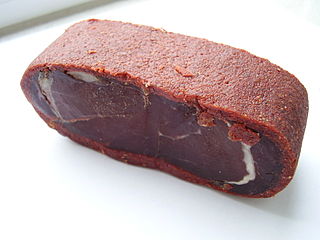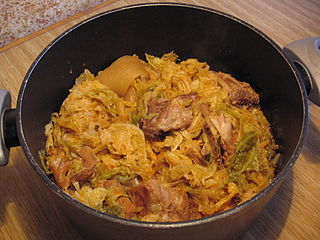
A sausage is a type of meat product usually made from ground meat—often pork, beef, or poultry—along with salt, spices and other flavourings. Other ingredients, such as grains or breadcrumbs, may be included as fillers or extenders.

Salami is a salume consisting of fermented and air-dried meat, typically pork. Historically, salami was popular among Southern, Eastern, and Central European peasants because it can be stored at room temperature for up to 45 days once cut, supplementing a potentially meager or inconsistent supply of fresh meat. Countries and regions across Europe make their own traditional varieties of salami.
Rakija, rakia, rachiu, rakı or rakiya, is the collective term for fruit spirits popular in the Balkans. The alcohol content of rakia is normally 40% ABV, but home-produced rakia can be stronger.

Pastirma or Pasterma, also called pastarma, pastırma, pastrma, pastourma, basdirma, basterma, basturma, or aboukh is a highly seasoned, air-dried cured beef that is found in the cuisines of Albania, Armenia, Bosnia and Herzegovina, Romania, Bulgaria, Egypt, Greece, Cyprus, Iraq, the Levant, North Macedonia, Azerbaijan, Turkey and Georgia.
Latvian cuisine typically consists of agricultural products, with meat featuring in most main dishes. Fish is commonly consumed due to Latvia's location on the eastern shore of the Baltic Sea.

Bulgarian cuisine is part of the cuisine of Southeast Europe, sharing characteristics with other Balkan cuisines. Bulgarian cooking traditions are diverse because of geographical factors such as climatic conditions suitable for a variety of vegetables, herbs, and fruit. Aside from the variety of local Bulgarian dishes, Bulgarian cuisine shares a number of dishes with its neighboring countries, in particular with Turkish and Greek cuisine.

Sirene, also known as "white brine sirene", is a type of brined cheese originating from Bulgaria. It is made of the milk of goats, sheep, cows, buffalo or a mixture thereof. It is slightly crumbly, with at least 46–48% of dry matter containing 44–48% of fat. It is commonly produced in blocks, and has a slightly grainy texture. It is used as a table cheese, in salads, and in baking.

Panagyurishte is a town in Pazardzhik Province, Southern Bulgaria, situated in a small valley in the Sredna Gora mountains. It is 91 km east of Sofia, 43 km north of Pazardzhik. The town is the administrative center of the homonymous Panagyurishte Municipality. Panagyurishte is an important industrial and economic center, the hub of the Bulgarian optical industry and a major copper extraction and processing site. According to the 2021 census, it had a population of 15,275. Panagyurishte is a town of significant historical importance, being the center of the 1876 April Uprising against the Ottoman Empire. The renowned Thracian Panagyurishte Treasure was found near the town.

Jamón is a type of dry-cured ham produced in Spain. It is one of the most globally recognized food items of Spanish cuisine. It is also regularly a component of tapas.

Sredna Gora is a mountain range in central Bulgaria, situated south of and parallel to the Balkan Mountains and extending from the river Iskar to the west and the elbow of river Tundzha north of the city of Yambol to the east. Sredna Gora is 285 km long, reaching 50 km at its greatest width. Its highest peak is Golyam Bogdan at 1,604 m (5,262 ft). It is part of the Srednogorie mountain chain system, which extends longitudinally across the most country from west to east, between the Balkan Mountains and the Sub-Balkan valleys to the north and the Kraishte, Rila and the Upper Thracian Plain to the south.
Grape growing and wine production have a long history in Bulgaria, dating back to the times of the Thracians. There is evidence of Bulgarian winemaking since 4000 B.C. Wine is, together with beer and grape rakia, among the most popular alcoholic beverages in the country.

Skilandis or Kindziukas is a Lithuanian matured sausage made of meat, fat, salt, pepper and garlic. The ground meat is traditionally pressed into a pig's stomach or bladder, but today may be contained in other skins. The sausage is dried and cold-smoked. Skilandis dates back to at least the 16th century - the word skilandis is referred to in documents from various locations across the Grand Duchy of Lithuania as early as in the 16th-18th centuries.

Banya is a village in the Panagyurishte Municipality, Bulgaria. As of 2007 it has 856 inhabitants. The village is known throughout the region with its mineral baths and its spa resort. The ruins of an ancient fortress are located 3 km to the south.

Bata is a village in the Panagyurishte municipality in western Bulgaria. It has 1 345 inhabitants.

Lombard cuisine is the style of cooking in the Northern Italian region of Lombardy. The historical events of its provinces and of the diversity of its territories resulted in a varied culinary tradition. First courses in Lombard cuisine range from risottos to soups and stuffed pasta, and a large choice of second course meat or fish dishes, due to the many lakes and rivers of Lombardy.

Kielbasa is any type of meat sausage from Poland and a staple of Polish cuisine. It is also known in other world cuisines; in American English, the word typically refers to a coarse, U-shaped smoked sausage of any kind of meat, which closely resembles the Wiejskasausage.














